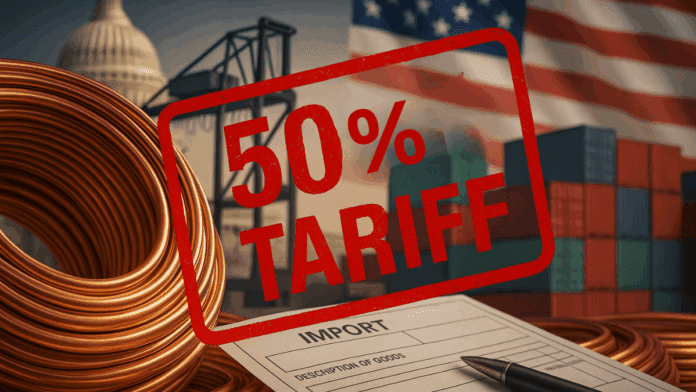President Donald Trump has announced a 50% tariff on all copper imports, a move that could shake industries across the country. This means that companies bringing copper into the U.S. from other countries will have to pay half the value of that as a fee.
The announcement came during a Cabinet meeting on Tuesday, where Trump confirmed that copper would be hit first among a series of new industry-specific tariffs. Commerce Secretary Howard Lutnick later stated that the tariff would likely take effect by August 1, following the completion of a formal review into the metal’s impact on national security.
Copper prices jumped immediately following the tariff announcement. In New York, futures jumped by as much as 17% in a single day—the sharpest intraday rise recorded since at least 1988.
In 2024, the United States consumed about 1.6 million tons of copper but produced only 850,000 tons domestically. To fill the gap, it relies heavily on imports—mainly from Chile (38%), Canada (28%), and Mexico (8%). With the new 50% duty, these imported supplies will become significantly more expensive for American buyers.
U.S. Unleashes New Trade Weapon—25% Tariffs to Hit Japan, South Korea
Why EVs and Data Centers Need So Much Copper
Copper is a critical material used in almost every piece of modern technology. It is especially important for building electric vehicles (EVs), data centers, renewable energy systems, and power grids.
An electric vehicle needs about four times more copper than a gas-powered car. That’s because it’s vital for electric motors, batteries, and charging systems. Automakers like Tesla, Ford, and GM rely heavily on this metal to build their electric models.
With the new tariff, car manufacturers in the U.S. could face higher production costs, especially if they depend on imports. This might slow output or lead to higher prices for consumers.
Data centers, which are the backbone of the internet and cloud computing, also depend on copper. From server racks to cooling systems and power supplies, the metal is used to conduct electricity and keep operations stable. Tech companies running large server farms—like Google, Amazon, and Microsoft—will likely be impacted by the higher metal prices.
Additionally, copper is key to building wind turbines, solar farms, and electric grids. As the U.S. pushes for cleaner energy, demand continues to grow. A sudden rise in price could make it more expensive to build and maintain renewable energy infrastructure.
US Slaps 20% Tariff on Vietnam Imports as Trump Announces New Deal
Industry Shock and Market Reaction
The new tariff marks a major shift in U.S. trade policy. During Trump’s first term, similar duties were imposed on steel and aluminum, but this time, the focus has turned to copper that had largely escaped attention—until now.
The move could disrupt long-standing supply chains, especially for industries that rely on consistent imports from key partners like Chile and Canada. With overseas sources currently supplying over a third of the nation’s demand, the impact is expected to be immediate.
Manufacturing, automotive, and tech companies are already scrambling to adjust their budgets and sourcing strategies. As prices surge following the announcement, many fear this could signal larger supply chain disruptions across critical sectors.
Commerce Secretary Lutnick confirmed that the government’s investigation into copper imports had found enough reason to move forward. “Copper is finished. We’ve handed the study over to the president,” he said. “The president knows that he has the ability… to set the market tariff for copper.”
The coming weeks will reveal how deeply this move cuts into tech and green energy progress. For now, one thing is clear: the cost of copper is going up, and the industries that need it most are feeling the heat.
